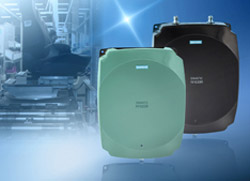Compact UHF readers for production and production-related logistics

Simatic RF620R is equipped with an integrated UHF antenna and up to two external UHF antennas can be connected to the Simatic RF630R. With Simatic RF communication modules, the devices can be integrated directly into Simatic S7 as well as Profinet/Profibus communication networks.
For this purpose, standard function blocks are available for the Step 7 engineering software. The two stationary readers from the Simatic RF600 family can be installed in constricted spaces thanks to their compact design and they can be used in harsh industrial environments due to the high degree of protection (IP65). The new devices are capable of reliable selective “tag” identification and secure data communication.
They are suitable for directly identifying objects at short to medium write/read distances of up to three meters. The main application areas of the readers are applications using Simatic automation technology and transponders according to the standards EPC Gen2 and ISO 18000-6C. These applications are typically found in production control, material handling control and in tracking and tracing.
The new readers now allow the setting up of process chains which are completely equipped with UHF technology according to ISO and EPC standards, from goods receipt, through production, to goods issue.
Media Contact
More Information:
http://www.siemens.com/simatic-sensors/rfAll latest news from the category: Machine Engineering
Machine engineering is one of Germany’s key industries. The importance of this segment has led to the creation of new university degree programs in fields such as production and logistics, process engineering, vehicle/automotive engineering, production engineering and aerospace engineering among others.
innovations-report offers informative reports and articles covering technologies such as automation, motion, power train, energy, conveyor, plastics, lightweight construction, logistics/warehousing, measurement systems, machine tools and control engineering.
Newest articles

A universal framework for spatial biology
SpatialData is a freely accessible tool to unify and integrate data from different omics technologies accounting for spatial information, which can provide holistic insights into health and disease. Biological processes…

How complex biological processes arise
A $20 million grant from the U.S. National Science Foundation (NSF) will support the establishment and operation of the National Synthesis Center for Emergence in the Molecular and Cellular Sciences (NCEMS) at…

Airborne single-photon lidar system achieves high-resolution 3D imaging
Compact, low-power system opens doors for photon-efficient drone and satellite-based environmental monitoring and mapping. Researchers have developed a compact and lightweight single-photon airborne lidar system that can acquire high-resolution 3D…





















